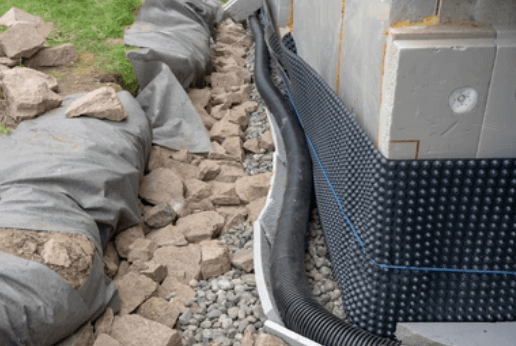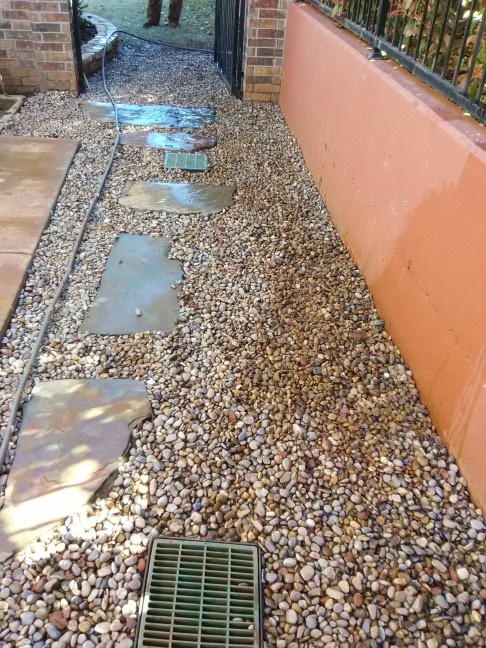Everything You Need to Know About the Portland French Drain Process
Everything You Need to Know About the Portland French Drain Process
Blog Article
The Important Guide to Maintaining Your French Drainpipe for Durable Efficiency
Preserving your French drain is essential to its performance and your residential property's defense. Routine checks can save you from costly repairs and water damage. You'll need to know what signs to look for and just how usually to examine your system. Plus, understanding the cleansing procedure can make a considerable difference. Let's explore the essential actions for guaranteeing your drain functions well for many years to come.
Recognizing the Feature of a French Drain
A French drainpipe is an essential element in managing water around your home. It directs excess water far from your foundation, protecting against flooding and damages. When heavy rainfall falls, the drainpipe gathers water through a perforated pipeline buried in crushed rock. This system enables water to move easily, minimizing pressure on your cellar walls and lessening the risk of leaks.You might ask yourself exactly how it functions in practice. As water fills the dirt, gravity pulls it towards the drain. The perforated pipeline records this water, delivering it to a marked drain area or tornado sewage system. This procedure maintains your lawn completely dry and safeguards your home's architectural integrity.Understanding how a French drainpipe features is vital to appreciating its significance. By effectively funneling water away, it assists maintain a secure and completely dry living environment. Maintaining your French drain in top problem warranties you prevent costly repairs down the line.
Routine Inspections: What to Search for
Beginning by checking for any kind of clogs that could be obstructing water flow when you're examining your French drain. Take notice of indicators of surface area disintegration around the drainpipe, as this can suggest potential concerns. Normal assessments will certainly aid maintain your drainage system operating properly.
Blocked Drain Analysis
Just how can you tell if your French drain is clogged? Watch for water merging in your yard, particularly after hefty rain. That's a red flag if you discover locations where water accumulates rather of draining pipes. You should additionally examine the drainpipe outlet; if water isn't moving out as it should, there's most likely a clog. Listen for unusual gurgling sounds, which can indicate trapped air. In addition, evaluate the drain's surface area for any kind of greenery growth, as roots can penetrate and block the system. If you smell mildewy smells, it might point to stagnant water created by an obstruction. On a regular basis reviewing these signs can assist you preserve your French drain successfully and prevent pricey fixings.
Surface Area Erosion Check

Cleansing Your French Drainpipe: Step-by-Step Guide
Cleansing your French drain is important for maintaining it working appropriately. You'll need some details tools and a clear process to guarantee whatever runs efficiently. Let's walk with the steps and pointers for maintaining your drainpipe successfully.
Tools You'll Require
To tackle the job of cleansing your French drain successfully, you'll desire to collect a couple of important tools. Order a strong set of gloves to protect your hands from debris and sharp objects. A tiny shovel or trowel will assist you eliminate dirt or clogs around the drain. For removing the inside, a plumbing's snake or a high-pressure water nozzle can be exceptionally helpful. You'll also need a container for accumulating any particles you take out. Having a yard hose on hand will certainly make it simpler to rinse out the drainpipe and guarantee it's moving efficiently. With these tools ready, you'll be established for a thorough cleaning session!
Cleaning Process Steps
Begin by assessing the area around your French drain for any kind of visible particles or blockages. Get rid of leaves, branches, or dust that may block water circulation. Next off, check the inlet and electrical outlet areas; clear any type of blockages to assure appropriate drainage. Utilize a yard pipe to flush the drain, directing water right into the inlet. This aids dislodge any kind of accumulated sludge or debris. If you discover persistent blockages, consider making use of a plumbing technician's snake to damage them up. After cleaning, check the gravel around the drainpipe; replenish it if it's cleaned away. Verify the drainpipe covers are undamaged and safely in place to avoid particles from entering. Routine cleansing maintains your French drain operating efficiently.
Upkeep Regularity Tips
While normal upkeep is important for your French drain's durability, knowing how frequently to maintain it can make all the difference. Ideally, you need to check your French drainpipe at least twice a year, preferably in spring and fall. After hefty rains or snowmelt, check for obstructions or particles. If you notice any kind of standing water, it's time to clean your drain.In locations with heavy foliage, even more constant upkeep-- regarding every 3 months-- might be needed. Furthermore, think about cleansing your French drain after significant storms or if you observe water pooling in your yard. By staying aggressive, you'll assure your French drain functions efficiently and safeguards your residential or commercial property from water damage. Routine checks will certainly save you money and time in the future.
Recognizing Common Problems and Their Solutions
When you see water merging in your lawn or damp areas in your cellar, it's important to recognize common issues with your French drainpipe and carry out effective options. One regular trouble is clogging, frequently triggered by debris like leaves or sediment. To repair this, a fantastic read you can utilize a plumbing serpent or a high-pressure water jet to clear blockages.Another concern may be incorrect incline. Water will not move away from your home if your drain isn't sloped appropriately. You can adjust the incline by excavating and rearranging the drain pipe.Lastly, look for damages or splits in the drain itself. Changing the harmed sections is vital for peak efficiency if you locate any kind of. By dealing with these concerns promptly, you'll aid guarantee that your French drain remains to operate effectively, safeguarding your property from water damages and preserving a dry, risk-free setting.
Seasonal Maintenance Tips for Your French Drainpipe
Resolving usual concerns with your French drain is simply the primary step in ensuring its long-term effectiveness. Seasonal maintenance is crucial for peak efficiency. In the springtime, remove leaves and particles that may have gathered throughout wintertime. Look for any type of obstructions in the outlet or catch container, as water requires a clear path to stream freely.During summer season, evaluate your drainpipe my site for any indications of changing or resolving soil. Make sure it's still degree and functioning effectively. As autumn approaches, clear out any type of dropped leaves to prevent blockages prior to winter months arrives.In winter season, watch for freezing temperatures. Make certain your drainpipe isn't at danger of cold if you live in a chilly climate. Protecting revealed pipelines can assist. Regular checks and prompt maintenance can avoid expensive repairs and keep your French drain working properly year-round. Remain aggressive and appreciate satisfaction knowing your drainage system remains in good condition!
When to Contact a Specialist
Knowing when to hire an expert can conserve you time and prevent additional damage to your French drainpipe. If you observe consistent standing water in your lawn, it's a clear indicator that your drain might be blocked or damaged. Do not disregard strange smells, as they can indicate sewer back-up or decay, which requires immediate attention.If you find that your drainpipe isn't functioning correctly after efforts to tidy or preserve it, it's time to connect for expert assistance. Furthermore, if you're not sure about the underlying issues or lack the needed tools, employing a professional can provide peace of mind.Finally, if your French drain is old or has actually experienced considerable damage, professional analysis can identify whether repairs or full replacement is required. Count on the specialists to ensure your water drainage system works successfully for years ahead.
Tips for Protecting Against Future Drainage Troubles
To keep your French drain operating efficiently, on a regular basis evaluating and maintaining it can make all the distinction. Beginning by clearing particles, leaves, and dust from the surface and drainpipe openings. This prevents obstructions that can bring about water backup. Inspect the crushed rock around the drainpipe; if it's compacted or worn down, consider adding fresh gravel to keep ideal flow.Next, divert water away from your drainpipe by guaranteeing downspouts and rain gutters are clear and routing water a minimum of three feet far from your structure. Consistently evaluate for any kind of indicators of damage or drooping. If you notice concerns, resolve them immediately.Finally, think about setting up a catch or a filter basin to trap larger debris prior to it gets in the drain. By staying proactive with these ideas, you'll reduce the risk of future drain troubles and keep your French drain in anonymous leading shape.
Often Asked Questions
How much time Does a French Drain Normally Last?
A French drainpipe commonly lasts around 30 to 40 years, depending on the materials utilized and maintenance (Portland French Drain). If you stay on par with regular checks, you can prolong its life expectancy also additionally
Can I Set Up a French Drainpipe Myself?
Yes, you can set up a French drain on your own if you've got the right devices and expertise. Just make certain to prepare very carefully, adhere to local guidelines, and warranty proper drain to prevent future concerns.
What Materials Are Utilized in a French Drainpipe?
You'll require perforated pipeline, gravel, landscape material, and a strong drain pipeline for your French drainpipe. These materials help redirect water efficiently, stopping flooding and maintaining your property dry and safe from water damage.

Is a License Required to Install a French Drainpipe?
You'll likely need a permit to mount a French drainpipe, depending upon neighborhood policies. Consult your community to guarantee you adhere to any kind of required guidelines and avoid potential concerns throughout setup.
What Are the Expenses Related To French Drain Maintenance?
Maintaining a French drainpipe typically sets you back in between $100 and $500 every year. You'll require to take into account expenses for cleaning, fixings, and examinations. Normal maintenance helps avoid larger assurances and expenses your system operates effectively for many years - Portland French Drain. When you're inspecting your French drain, start by examining for any type of clogs that may be obstructing water circulation. By staying aggressive, you'll assure your French drainpipe features successfully and protects your residential or commercial property from water damages. When you discover water merging in your backyard or damp spots in your cellar, it's important to determine usual issues with your French drainpipe and implement effective options. You can adjust the slope by excavating and repositioning the drain pipe.Lastly, check for damages or cracks in the drainpipe itself. Inspect the gravel around the drain; if it's compacted or deteriorated, consider adding fresh crushed rock to maintain suitable flow.Next, divert water away from your drainpipe by ensuring rain gutters and downspouts are clear and guiding water at the very least three feet away from your foundation
Report this page